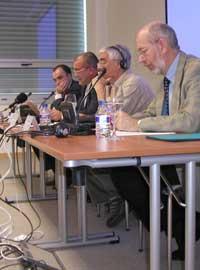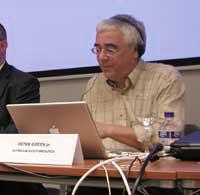Yesterday the meetings Research and Society
2006/06/30 Kortabitarte Egiguren, Irati - Elhuyar Zientzia


The event was inaugurated by José María Rodríguez Ibabe, president of the Elhuyar Foundation. After talking about the work done by the Elhuyar Foundation to socialize science, the turn of the talks came. Peter Green
Alphagalileo, Director of Development of the Foundation, Alberto Ansuategi, Director of Scientific Policy of the Department of Education of the Basque Government, and Juan Ignacio Pérez Iglesias, Rector of the University of the Basque Country took the floor.
Peter talked about the Green Communiqué project, among other topics. Communiqué focuses on the evaluation and creation of a European news agency specializing in science and technology. This is a project jointly promoted by the Alphagalileo Foundation and the European Commission, which has already been presented in Great Britain, Germany, France, Czech Republic, Barcelona and San Sebastian. In this
regard, he stressed that neither the European media nor the outside media give the necessary importance to European research and that measures must be taken to change this situation. He believes that a bridge must be built between researchers and the media. That is the intention of Communiqué. It also considers that the performance of those responsible for the press, who need training, who are offered tools, etc. must be improved. He ended his speech by saying that scientific news should come out of specialized journals and take them to the local press. And, of course, it gave everyone the opportunity to participate in the Communiqué project.
Alberto Ansuategi, director of Scientific Policy of the Basque Government, then took the floor, who undoubtedly began his speech saying that the relationship between society and science is quite complex. However, he noted the three challenges he faces with the aim of improving this aspect: on the one hand, bringing science and technology closer to the public, also from an academic point of view; on the other, bringing scientific policy closer to society; and finally, encouraging the proper use of science in all policies, strengthening scientific and technological actions. The
last individual conference was given by the rector of the UPV, Juan Ignacio Pérez. He also pointed out that it would be an opportunity to make public a reflection that had been in mind for a long time. Thanks to science, the human being has achieved a better quality of life. Therefore, we live better than 100 years ago, among other aspects in food, transport and technology. It often feeds on scientific distrust. To explain it, he took as an example the case in which the weather forecasts of the television indicate the times of war at the beginning of each station. In this case, believing or evident knowledge is assimilated to scientific data, that is, to science. The affected is the science itself, of course. In
his opinion, the foundations of science are often questioned, and when this happens, society is ultimately what is questioned.
"The dissemination of science and technology is very important, because knowledge of science makes us freer," said the rector. With this phrase he ended his activity.
Science in the Press
Next, the research was presented in Science Press, which analyzes the treatment of science and technology in the daily press. Another year, for four months, the Elhuyar Foundation has analyzed eight newspapers (Berria, El Correo, Gara, El Diario Vasco, Deia, Diario de Noticias de Alava, Noticias de Gipuzkoa and El País). Every
four days there is some scientific and technological news on the cover of some of the newspapers published in the CAPV. Newspapers published from mid-December last year to mid-April this year have been the focus of 29 scientific and technological news. However, scientific and technological news have appeared more on the cover, albeit more modestly. This is one of the conclusions of the study.
Apart from newspaper covers, the leading role of science and technology in newspapers is 1.96% of the total area of newspapers. There is a slight decrease from the previous year. El Correo and Berria
are the newspapers that devote the most space to science individually, while El Diario de Noticias de Alava are the least. Quality measurement has
measured the level of news production rather than the quality of writing. The most direct conclusion is that the short news formula is widely used in the dissemination of science and technology and treated articles are intended for additives. In addition, it has been concluded that the degree of specialization of science and technology journalists is relatively low. Although
the most important research tool has been newspapers, specialized scientific journals have also been consulted. The goal has been to make a comparison to see if specialized magazines and newspapers have the same points of interest. It has been proven that the news that has had a great importance for specialized magazines has also taken place in the daily press.
Wide and varied theme in the round table

After a short break, the central event of this meeting was held, a round table on "Research and Society". Fernando Plazaola, professor of physics at the University of the Basque Country and director of the magazine Ekaia, was the moderator. Around him, Manuel Tello, Professor of Physics at the UPV, Peter Green, Itziar Nogeras, Director of the Elhuyar Foundation and Jose Manuel Abad, Head of Communication at the Spanish Foundation for Science and Technology. All
of them focused on the need to publish scientific and technological research and the problems that researchers and journalists had to carry out this work.
In general, the media barely divulge science. "In the newspapers the New York Times is the benchmark, and the rest are just the efforts made to do something similar to him."
Peter Green also sees the need to transmit or communicate information. But we have to find a way to move all the subjects to society, also the topics of science and technology. And it is that many times when talking about science only data is given and it must be enriched in some way. Science also has to be attractive. Regarding
this attraction, the director of the Elhuyar Foundation, Itziar Nogeras, said that the greater the presence of these issues, the more attractive they should have. In addition, there is interest in these issues, at least 78% of the European population, according to data from the survey conducted by the Eurobarometer.
In the same line José Manuel Abad took the word. He stressed that issues of general interest should be of interest to all. This requires specialized people. In fact, for an astronomer, the most complicated question is what a child can ask: "Why is the sky blue? ". How to explain it? How to disclose? Manuel Tello believes that
the dissemination of science must be done by scientists and others. And they have to convey the message to society in the language of the street. But communication is something else. The journalist should be able to distinguish whether a story is important or not, among other things. After
heating the room atmosphere and listening to the words of the attendees, researchers and journalists gathered in the room shared their opinions. It was also commented that the pace of work of journalists and scientists was very different. Undoubtedly, the subject was to speak long and tense. Again.



